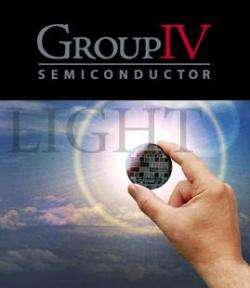March 6, 2008 weblog
Silicon Light Bulbs to Compete with Fluorescent Bulbs

Thomas Edison invented the light bulb in 1880, and, since the 1920s, the incandescent light bulb has remained largely unchanged. While that's a testament to Edison's ingenuity, it's also a bulb that uses up to 95% of its power to generate heat rather than light.
In order to improve this efficiency, the fluorescent bulb has recently gained popularity as an alternative that uses about 25% of its power for light and lasts up to 10,000 hours, compared with the incandescent bulb's 1,500-hour lifetime. However, unlike the recyclable incandescent bulb, fluorescent bulbs contain phosphor and mercury - toxic chemicals that could pose disposal problems on a large scale.
But a company from Ottawa, Canada, is hoping to create a light bulb that further increases the efficiency of fluorescent bulbs, while using completely non-toxic materials. Since 2003, Group IV Semiconductor has been working on a unique bulb design, one that uses a tiny computer chip in place of a traditional wire filament or gas.
The new bulbs, officially called solid state light bulbs, use low-cost silicon technology originally developed for fiber optic networks in the early 2000s. The chips were intended to boost the light signal, increasing its speed and allowing it to travel longer distances. Today, silicon is widely used in cell phones, computers, and other electronics.
But as the telecommunications market began to lose its appeal, Group IV's chief executive Stephen Naor looked into other applications. As he explains, in North America alone, 2.2 billion light bulbs are replaced every year, and lighting is a $12-billion global industry.
Several countries, including the UK and Australia, have laws to ban incandescent bulbs by 2011. Other countries, including the US, are considering bans. As it stands, fluorescent bulbs are currently the main replacement bulb.
But solid state light bulbs could offer a non-toxic alternative, better lighting quality and higher efficiency than fluorescent bulbs. While some types of solid state lighting exist, they are currently too expensive for mass production. For example, LEDs use expensive semiconductors such as gallium nitride, rather than silicon, and often give off an undesirable bluish hue.
But the challenge with using silicon is that the material is poor at emitting light. To solve this, Group IV uses electrical current to energize electrons within silicon quantum dots, which give off energy in the form of photons. Naor hopes to have final prototypes of the technology by 2010, with bulbs on store shelves by 2011 that cost about the same as fluorescent bulbs.
The company has attracted several big investors, such as Vinod Khosla, the founding chief executive of Sun Microsystems. Applied Materials Inc., which makes manufacturing equipment, plans to help Group IV ramp up production of the bulbs once the prototypes have been perfected. Then Group IV plans to sell the microchip technology to major electrical companies such as General Electric, which will incorporate the chip in their own bulb production.
More information: www.GroupIVSemi.com





















